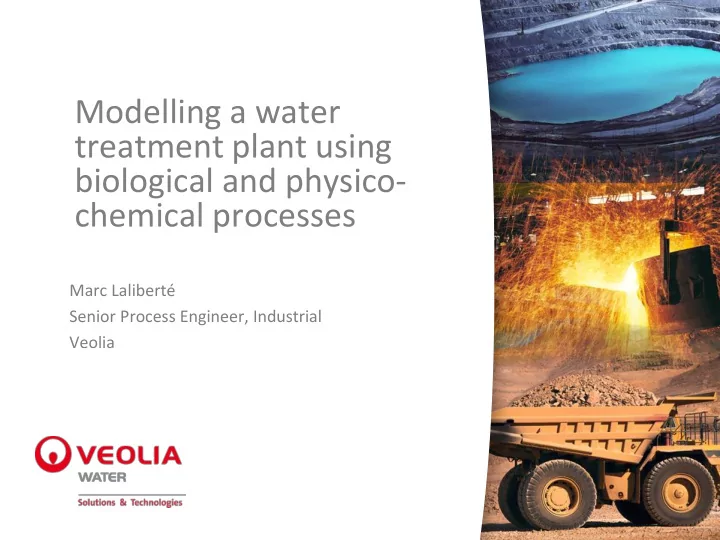

Modelling a water treatment plant using biological and physico- chemical processes Marc Laliberté Senior Process Engineer, Industrial Veolia
Contents 1. Introduction 2. Process Development 3. Modelling 4. Conclusion 2
1 Introduction Us (Veolia) Our Client (Pretium) The permitting process
Veolia: We treat water 4 4
Pretium’s Brucejack Project New gold mine being developed Located approximately 65 km north of Stewart in NW British Columbia. Probable mineral reserves of 6.6 million ounces of gold Currently in exploration phase Started permitting for the construction and operation phases 5
Permitting Process Highly sensitive area BC government has been very proactive regarding environment Permitting is done by phase • Exploration, Construction, Operation, Closure • Exploration and Construction criteria are less stringent (impacts are lower) • Operation criteria are very stringent 6
2 Process Development Expected Water Quality and Criteria Metal Removal Nitrogen Removal Polishing The proposed system
Expected Water Quality and Criteria Parameters • Metals, such as Ag, Cd, Co, Cu, Cr, Fe, Ni, Zn • Anions, such as Cl, SO 4 and NO 3 • Nitrogen Species, such as NH 3 , NO 2 (and NO 3 ) • Criteria are typically sub ppm, some are sub ppb • Little BOD and organics, neutral pH, lot of TSS Exact quality is not known Using predictions from geochemical kinetic studies • Confirmed in lab on synthetic water made to match predicted quality • However there are uncertainties... 8 Lorax
Metal Removal BATEA (Best Available Technology Economically Achievable): • Lime precipitation • Enhanced Coagulation and Settling pH to be optimized to get best metal removal SLUDGE HYDROCYCLONE MICROSAND + SLUDGE POLYMER MICROSAND CLARIFIED WATER COAGULANT LAMELLA RAW SCRAPER WATER COAG. INJ. MATUR. TANK TANK TANK SETTLING TANK PUMP 9
Nitrogen Removal BATEA: • NH 3 , NO 2 : Active Aerobic Biological Oxidation + + 3/2 O 2 = NO 2 - + 2 H + + H 2 O NH 4 - + ½ O 2 = NO 3 - NO 2 • NO 3 : Active Anoxic Biological Reduction Aerobic reactor 2 NO 3 - + 3 (CH 2 O) n = N 2 + 3 CO 2 +3 H 2 O • Using Moving Bed Biofilm Reactor Anoxic reactor 10
Polishing Removing TSS produced in Biological Reduction Also allow second stage of coagulation to remove leftover metals using complexation (adsorption) on ferric hydroxide • Key to achieving sub ppb levels Using same Enhanced Coagulation and Settling equipment 11
Proposed System Metal Precipitation Actiflo Reactors Polishing Actiflo Reactor Biological Reactors 12
3 Modelling Why model, and why model using ESP? Model Set-Up Chemical Precipitation Biological Treatment Polishing and Surface Complexation
Why model, and why model using ESP? Why model? • Can we meet the discharge criteria? • What’s the optimum pH? • Do we need to add sulfide? Why model using ESP? • ESP is the best modelling tool on the market for electrolyte-based processes • The interface looks primitive, but the software is very easy to learn and is intuitive 14
Model Set-Up Model : Aqueous Framework (H + based) • Mix-Solvent still incomplete with respect to heavy metals and metalloids • Concentrations are generally low, so aqueous framework should be OK Redox only applied when required • Redox and nitrogen species don’t mix well, require careful handling • As, N, Fe, Se, S only are used • Cr is assumed as Cr III Require validation, kinetic of biological oxidation / reduction is unknown Large number of species • Require two model restarts, but this is now handled well • Calculation times reasonable with today’s computers 15
Chemical Precipitation Easiest step No redox Simple mixers, separators • Sludge recirculation not modelled, irrelevant for this process • Will be physically present 16
Biological Treatment Redox used for oxidation only Oxidation done using ESP built-in equations (using O 2 from air) Reduction cannot be done that way • ESP does not recognize carbon based reducers • Had to use a reactor, so redox turned off • Methanol used for the purpose of the simulation • Other reducing reactions ignored Kinetics are not well known, but some reduction of As and Se is expected Small oxidation step at end to remove residual methanol • Will possibly oxidize back As and Se • Kinetics unclear, requires validation 17
Polishing and Surface Complexation Key step Very cumbersome to actually model Solid removal modelled in ESP Complexation calculations done offline in Excel using data from Dzombac and Morel Validated using lab data 18
4 Conclusion Next steps What did we learn? What tools are we missing?
Next Steps Complete Lab Validation Prepare Permit Request Build Equipment, Install and Commission Long-term follow-up to make sure water quality is as expected 20
What Did We Learn? Chemical precipitation is better defined • pH was optimized • Allowed us to really understand what’s happening Confirmed that criteria can be met Mass balance allow sizing of equipment and permitting 21
What Tools Are We Missing? Mix-Solvent vs Aqueous Framework • Mix-Solvent is probably better but incomplete • Until it is completed work will be done using Aqueous Framework Biological Redox • Require a way to have carbon species act in redox Many, many species, how to select? Surface Complexation • As we go from g/L to mg/L to ug/L... this becomes an essential part of modelling • Current implementation is poorly documented and difficult to use 22
What Tools Are We Missing? Inputs • Better interface with StreamAnalyzer Results Output • The whole interface need rethinking • pH with mixed phases • Elemental concentration Currently only molar flow... • Non Americans also use ESP ESP output should follow Windows localization Kinetics are ignored • Not sure how this could be handled 23
Recommend
More recommend